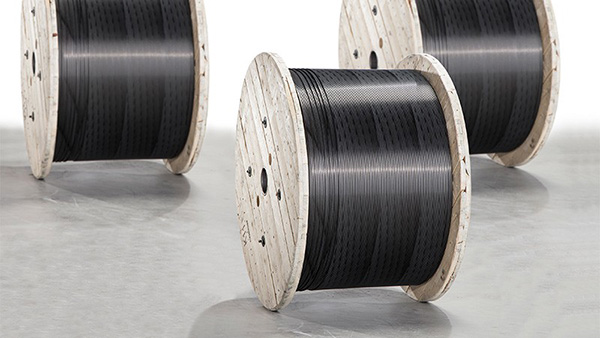Composite conductor cores could be key to unlocking the 1,000+ GW of clean energy projects awaiting approval in the United States.
According to Bill Gates, over 1,000 gigawatts of clean energy projects – approximately the current size of the entire U.S. power grid – are awaiting approval. Despite huge potential, infrastructure work on this scale is a huge undertaking so intelligent engineering and efficient design will be essential for return on investment for utilities providers. Here, Francesco Ierullo, head of sales for the Americas at Exel Composites, global composites manufacturer, explains how composite conductor cores can extend maintenance intervals, reduce infrastructure costs, and improve performance for power line installations.
Traditional conductors consist of an outer aluminum conducting ring and a reinforcing steel core — known as aluminum conductor steel reinforced (ACSR) conductors. However, their current capacity is limited by the steel core that has a high coefficient of thermal expansion, meaning the heat from the current passing through the conductor and the ambient temperatures cause the steel to expand.
That expansion, combined with the heavy nature of steel-reinforced cables, can lead to thermal sag during hot weather or times of high power demand, when the increased current generates heat. This cable distortion can cause short circuits and power transmission disruption: in July 2021, 6,000 people in Portland, Oregon faced a power outage due to sagging overhead powerlines during a heatwave.

Composite conductor cores present an alternative to the traditional ACSR core design. Carbon fiber has a much higher strength-to-weight ratio than stainless steel, 2457 vs 63 kN m kg-1, and tensile strength properties that outperform plastic and other non-metallic materials. Additionally, carbon fiber has a lower thermal expansion coefficient than steel S355, 12×10-6 K-1 compared to 0.8×10-6 K-1.
These facts mean composite-cored cables can be pulled tighter to prevent sagging and, even more advantageously, can be strung over longer distances. Reduced sag means longer cables means less frequent tower supports needed. In one project in the Western U.S., composite cores allowed design engineers to use a smaller diameter core and double the distance between support structures to 1,200 feet. Halving the number of support structures meant the total project cost was 15 per cent lower, which is important as carbon fiber cores are more expensive than ACSR.
Using composite cores also reduces maintenance requirements. For one thing, carbon fiber is corrosion-resistant, unlike steel, meaning cable replacement is needed less frequently. Furthermore, steel has approximately four times the relative density of carbon fiber, 7.8 vs 1.8-2.2. This means that far less strain is placed on the supporting structures by composite-cored cables, which lowers installation costs and facilitates more simple support requirements.
Despite the unfavorable trade-offs involved with ACSR cores, many utility companies are reluctant to perform a complete replacement of tower infrastructure as it requires a great amount of labor, time, and economic investment. This is particularly true in areas with uneven terrain, such as mountains where additional equipment such as helicopters may be required.
In place of a complete infrastructure replacement, ACSR lines can be upgraded to composite cored conductors. The light weight, lesser degree of thermal expansion and high tensile strength of carbon fiber means less is required to support cables. This allows for more conducting aluminum in the conductor and therefore increased transmission capacity.
The upgrade is significantly cheaper than total grid replacement, as it can reuse the existing pylon and tower infrastructure. The process is also substantially quicker, which minimizes disruption to energy supply. Additionally, if the composite cored conductors are used in a new area where the electrical infrastructure must start from scratch anyway, the high current capacity allows the tower count to be reduced.
Exel Composites’ experience in the electrical industry dates back to 1960: its carbon fiber composite cores are produced using cost-efficient continuous manufacturing processes of pultrusion and pull-winding, and can be spooled kilometers at a time to keep production costs low, while ensuring consistent quality.
To read more about applications of composites in utilities, visit the Exel Composites website.
For further information contact: Exel Composites PLC, Group Management Office, Mäkituvantie 5, FI-01510 Vantaa, Finland
Telephone: +358 20 754 1350
www: https://www.exelcomposites.com/
LinkedIn: https://www.linkedin.com/company/exel-composites/
Press enquiries: Patrick Ball or Greg Coppack – Stone Junction Ltd
Suites 1&2 The Malthouse | Water Street | Stafford | Staffordshire | ST16 2AG
Telephone: +44 (0) 1785 225416
e-mail: patrick@stonejunction.co.uk or greg@stonejunction.co.uk
www: www.wechangeminds.com
Twitter: https://twitter.com/StoneJunctionPR
Facebook: http://www.facebook.com/technicalPR
LinkedIn: https://www.linkedin.com/company/stone-junction-ltd
About Exel Composites
At Exel Composites, we use over 60 years’ experience to solve challenges and help customers save resources. Our forward-thinking composite solutions made with continuous manufacturing technologies serve customers in a wide range of industries around the world. You can find our products used in applications from wind power and transportation to building and infrastructure.
Our collaborative approach and global footprint set us apart from our competition. We use our expertise to help customers reduce weight, improve performance and energy efficiency and decrease total lifetime costs. We want to be the first choice for sustainable composite solutions globally.
Headquartered in Finland, Exel Composites employs approximately 650 forward-thinking professionals around the world and is listed on Nasdaq Helsinki. To find out more about our offering and company please visit exelcomposites.com.
Scott Ellyson, CEO of East West Manufacturing, brings decades of global manufacturing and supply chain leadership to the conversation. In this episode, he shares practical insights on scaling operations, navigating complexity, and building resilient manufacturing networks in an increasingly connected world.